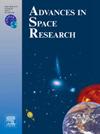Annular solar eclipse effects observed over Mexico on October 14, 2023: A multi-instrument study
IF 2.8
3区 地球科学
Q2 ASTRONOMY & ASTROPHYSICS
引用次数: 0
Abstract
The study reports results of the unique experiment during the annular solar eclipse of October 14, 2023, over in Mexico. Vertical and oblique sounding, satellite, magnetometer, solarimetric and GNSS-derived data were used. Eclipse parameters were reconstructed at different heights. The southeastward eclipse penumbra movement intensified the electron density (Ne) decrease caused by the regular byte-out. The westward movement of the ionospheric structures with time (diurnal Ne maximum and the poleward side of EIA) related to the midday hour mitigated this decrease to some extent. The influence of the poleward side of the northern EIA crest on the eclipse day was noticeable in latitudes lower ∼21°N. The largest decrease of foF2 by 2.67 MHz (21.89 %) and F2MOF by 2.49 MHz (16.6 %) were observed ∼67 and ∼75 min after the eclipse maximal phase, respectively. Two-hop mode propagation was affected earlier and stronger than one-hop. F1 layer was absent at some hours due to the decreased ionization flux. Es layer was partially absent and, when appeared, showed its decreased electron concentration. The absorption level decreased due to the weakened solar ionization flux. ∼(43–45)% of the electron density decrease registered with vTEC occurred above the F2 layer and was faster than in the F2 layer because the eclipse passage tangential velocity was higher at the higher heights. The Ne recovery was much slower than its decrease and with almost the same rate of change in F2 layer and the above heights. The maximal Sun’s and Moon’s discs Overlap was not the leading factor in vTEC response. Sun’s elevation and eclipse velocity played an important role. vTEC response end was not defined by the eclipse end. Atmospheric acoustic-gravity waves originating from the eclipse passage caused a spectrum of ionospheric irregularities. Crescent- and knot-type small-scale TIDs were typical in vertical sounding ionograms. Filtered sTEC series revealed the individual small-to-medium scale TIDs triggered by the fronts of the forward quasi-oval eclipse contours of Overlap ≤ 0.6 and backward contours of Overlap ≤ 0.8. The contours of 0.01 ≤ Overlap ≤ 0.952 were responsible for wave-packet medium-scale TIDs. D2fi small-scale weak turbulences were triggered by the atmospheric perturbations below the ionosphere which in turn were caused by the annular eclipse (Overlap = 0.952). All TIDs lived after the eclipse end. The recombination of O+ was less compensated by the photoionization during the eclipse and the thermospheric O/N2 ratio increased. At the ground level, under Overlap = 0.8, the solar irradiance decreased by ∼(78–92) % in the short-wave and by ∼(4–6) % in the long-wave range, and the air temperature decreased by −2 °C.
求助全文
约1分钟内获得全文
求助全文
来源期刊

Advances in Space Research
地学天文-地球科学综合
CiteScore
5.20
自引率
11.50%
发文量
800
审稿时长
5.8 months
期刊介绍:
The COSPAR publication Advances in Space Research (ASR) is an open journal covering all areas of space research including: space studies of the Earth''s surface, meteorology, climate, the Earth-Moon system, planets and small bodies of the solar system, upper atmospheres, ionospheres and magnetospheres of the Earth and planets including reference atmospheres, space plasmas in the solar system, astrophysics from space, materials sciences in space, fundamental physics in space, space debris, space weather, Earth observations of space phenomena, etc.
NB: Please note that manuscripts related to life sciences as related to space are no more accepted for submission to Advances in Space Research. Such manuscripts should now be submitted to the new COSPAR Journal Life Sciences in Space Research (LSSR).
All submissions are reviewed by two scientists in the field. COSPAR is an interdisciplinary scientific organization concerned with the progress of space research on an international scale. Operating under the rules of ICSU, COSPAR ignores political considerations and considers all questions solely from the scientific viewpoint.
 求助内容:
求助内容: 应助结果提醒方式:
应助结果提醒方式:


